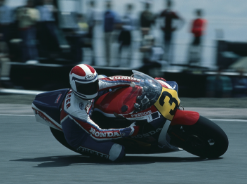NS500 Delivers Honda Its First Premier Class Riders’ Title in 1983
As a matter of urgency during the H-Y War
You must win at all costs

NR500's first test run was held at Suzuka Circuit in June 1979. The one with a yellow helmet is Takazumi Katayama. Another one in a leather suit is Mick Grant. Between the two riders, Shoichiro Irimajiri, general manager in charge of all motorcycle development at Honda around that time, is showing an anxious look on his face. (Photo/Honda)
It was a group of engineers around the age of thirty who played a central role in the development of the NR500. Although they had no experience in developing racing motorcycles, they determined the cause of problems and improved the bike quickly. They were fully motivated to beat 2-stroke racers with their NR using the new technology of oval cylinders/pistons. All that was needed was a little more time and effort.
However, Honda had no time to spare because they were in the heat of the H-Y War, a conflict between Honda and Yamaha over a bike market that broke out in 1979. Yamaha was increasing its sales in 1980 while Honda fuelled product development. Losing was unacceptable even in races. Anything and everything became a must-win.
Shoichiro Irimajiri played a role as Honda's commander in the H-Y War. Actually, he was managing director of Honda R&D Co., Ltd. in those times; he was in charge of all Honda motorcycle development and racing activities. In late 1980, Irimajiri got a proposal from Shinichi Miyakoshi, chief engineer at Honda R&D and leader of motocross activities. What he brought was an idea for a GP500 road racer with a 2-stroke engine.
2-stroke 3-cylinder engine
Was not mediocre

In October 1981, Honda completed a prototype of NS500 with a newly developed 2-stroke V-type 3-cylinder engine. It took only nine months from the start of the project. (Photo/Honda)
It became obvious that they could not afford to pursue the "creation of innovative technology" set as a goal when they chose 4-stroke for NR500. Using 2-stroke is favorable to get more power with the same displacement and the same number of cylinders. Besides that, it was expected that the engineers in Miyakoshi's motocross team would make use of the knowledge about 2-strokes that had already been deepened, and realize winning performance soon.
However, if that was the only reason, Irimajiri might not have been interested in the proposal. Miyakoshi's idea, which was far from mediocre, was to create a 3-cylinder engine instead of the 4-cylinder engine used by Yamaha and Suzuki. The purpose was to make it lighter than anything available then. And also by making the engine more compact, the frontal projected area was narrowed to reduce air resistance, and the goal was to achieve top speed on a par with 4-cylinder machines, which could not compete in terms of absolute power.
Another thing was Miyakoshi's proposal included piston reed valves while both Yamaha and Suzuki used rotary disc valves as the intake method for the 2-stroke engines. Back in those days, push-start was adopted in the World Grand Prix and NR500 was obviously inferior to the 2-strokes in terms of engine startability. When switching from 4-stroke to 2-stroke, they would choose the reed valve system because of its less intake resistance than the rotary disc valve system. Thanks to the knowledge accumulated through developing 2-stroke motocrossers, it was expected to change the startability of the engine by adopting a reed valve system.
Commander Irimajiri decided to develop a 2-stroke road racer. He was the inventor of the NR500's distinctive feature, the oval piston/cylinder with a total of eight intake/exhaust valves for each cylinder. In other words, the transition to 2-stroke was nothing but the creator putting an end to the 4-stroke NR500.
However, Irimajiri had no negative thoughts. He knew inside that the goal was constantly updated and he thought about reaching it in the shortest distance. To win as soon as possible, and as a way of achieving that, the 2-stroke was a rational choice. He had no hesitation.
In January 1981, the development project for the 2-stroke GP500 road racer was started. At that time, Honda called the Grand Prix-like road race "Sprint," and the 2-stroke racer was named "New Sprint," and the abbreviation "NS" was adopted.




